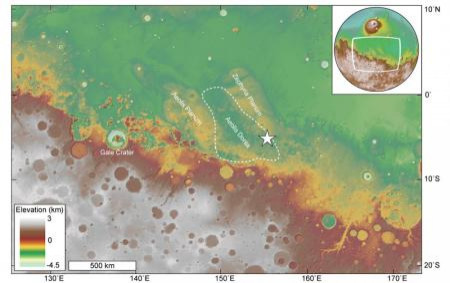Ancient Ocean On Mars? Study Shows ‘Most Convincing’ Evidence Of Unconfined Delta [PHOTOS]


An ancient river delta leading to a giant ocean might have existed on Mars, according to a new study by California Institute of Technology. The vast body of water is believed to have covered up to one-third of the planet’s Northern Hemisphere.
While the rover Curiosity has helped establish that water did flow across Mars, big bodies of water are rare, Discovery News reports. Located on the Aeolis Dorsa, a vast plain about 620 miles east of Gale Crater, where NASA’s rover Curiosity is exploring, researchers spotted evidence of a series of inverted channels that led them to the conclusion that an ocean may have existed on the planet.
"Scientists have long hypothesized that the northern lowlands of Mars are a dried-up ocean bottom, but no one yet has found the smoking gun," Mike Lamb, an assistant professor of geology at Caltech and coauthor of the paper describing the results, said in a statement.
Still, the findings aren't definitive proof of ocean life, but it may be the strongest support yet, Roman DiBiase, a postdoctoral scholar at Caltech and lead author of the paper, said.
"This is probably one of the most convincing pieces of evidence of a delta in an unconfined region — and a delta points to the existence of a large body of water in the Northern Hemisphere of Mars," DiBiase said in a statement.
Caltech researchers used images taken from the Mars Reconnaissance Orbiter to study a 100-square-kilometer (39 square miles) area section of the Aeolis Dorsa. The area is covered in inverted channels, which are formed from coarse materials such as gravel and cobbles that are usually found on dried-up riverbeds.
The study, published in the July 12 issue of the Journal of Geophysical Research, analyzed the stratigraphic layers of the inverted channels to discover they were part of a delta that most likely emptied into a large body of water such as an ocean.
Other possibilities remain as to where the channels lead, which will require further study. Researchers say the next step toward proof lies in exploring the hypothetical ocean coastline to find any more evidence.
Paul Niles, a NASA scientist who specializes in the geologic conditions of Mars, says the study also sheds light on how deep the water was on Mars. "Before, we were just 'guestimating' how much water flowed by looking at how big the channel was," he told the Pasadena Star-News. "This time we can actually see where the water level was."
The channels were 16-32 feet deep and measured 32-65 feet across, showing the potential ocean was 1,000 years old, DiBiase said. While the existence of water may hint of ancient life forms, the findings also show how the ancient environment closely resembled life on Earth, researchers say.
"Scientists are finding a rich sedimentary record on Mars that is revealing its past environments, which include rain, flowing water, rivers, deltas and potentially oceans," Lamb said. "Both the ancient environments on Mars and the planet's sedimentary archive of these environments are turning out to be surprisingly Earth-like."
© Copyright IBTimes 2024. All rights reserved.






















